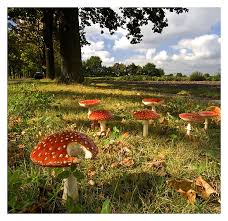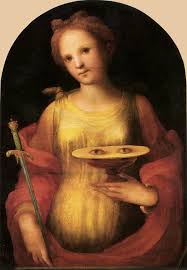This was the Golden Age that, without coercion, without laws, spontaneously nurtured the good and the true. There was no fear or punishment: there were no threatening words to be read, fixed in bronze, no crowd of suppliants fearing the judge’s face: they lived safely without protection. No pine tree felled in the mountains had yet reached the flowing waves to travel to other lands...no steep ditches surrounding towns, no straight war-trumpets...no swords and helmets. Without the use of armies, people passed their lives in gentle peace and security. The earth herself [Ops] also, freely, without the scars of ploughs, untouched by hoes, produced everything from herself. Contented with food that grew without cultivation, they collected mountain strawberries and the fruit of the strawberry tree, wild cherries, blackberries clinging to the tough brambles, and acorns fallen from Jupiter’s spreading oak-tree...Then the untilled earth gave of its produce and, without needing renewal, the fields whitened with heavy ears of corn. Sometimes rivers of milk flowed, sometimes streams of nectar, and golden honey trickled from the green holm oak.
December 17, 2009
Golden and Opulent
December 12, 2009
Coatlaxopeuh
 Light a candle for the Virgin of Guadalupe. To She who appeared to an Indian farmer, heralded by whistles and flutes, singing birds and heartbeat wings. The man to whom she chose to grant this vision was an Aztec descendant named Cuauhtlatoatzi (Talking Eagle), and renamed Juan Diego upon his conversion to Catholicism. She appeared to him as a beautiful woman with light brown skin, robed as an Aztec princess. On the hill of the shrine of Tonanztin she appeared, instructing that a chapel to the Virgin be built upon this site. She asked to be called The Virgin of Guadalupe. When a bishop demanded proof of the miracle, she instructed Juan to gather an armful of Castilian roses. Juan filled his cloak and returned to the bishop. But when he opened his cloak, instead of roses, the luminous image of Our Lady, surrounded by stars, was imprinted on the fabric, and the bishop fell to his knees in awe.
Light a candle for the Virgin of Guadalupe. To She who appeared to an Indian farmer, heralded by whistles and flutes, singing birds and heartbeat wings. The man to whom she chose to grant this vision was an Aztec descendant named Cuauhtlatoatzi (Talking Eagle), and renamed Juan Diego upon his conversion to Catholicism. She appeared to him as a beautiful woman with light brown skin, robed as an Aztec princess. On the hill of the shrine of Tonanztin she appeared, instructing that a chapel to the Virgin be built upon this site. She asked to be called The Virgin of Guadalupe. When a bishop demanded proof of the miracle, she instructed Juan to gather an armful of Castilian roses. Juan filled his cloak and returned to the bishop. But when he opened his cloak, instead of roses, the luminous image of Our Lady, surrounded by stars, was imprinted on the fabric, and the bishop fell to his knees in awe. December 10, 2009
Luce, Lucente, Lucia
December 7, 2009
At the midnight of the year, the night riders fly...

The Teutonic god Hold Nickar (Old St. Nick?) galloped through the sky during the winter solstice, granting favours to his worshippers below. The original Nordic leader of the hunt was Odin, known in Germanic myth as Wodan. Odin rode his eight-legged horse, Sleipnir. Today it is Santa who rides, with his eight reindeer.
* * * * * *
-from the "Sun in the Greenwood" ritual by John and Caitlin Matthews
***This article also appears in the Winter 2009 issue of Gaea's Own newsletter, which can be accessed here
December 5, 2009
Eve of St. Nicholas

When I was a little girl, my sisters and I would wake up on December 6 to the happy surprise of small gifts left to us by St. Nicholas, set upon the table by our places at breakfast. Not on the grand scale of Christmas, just a small gift and some candy, but that was enough to set a start the day off on a happy note. I recall the time we each got a 45 rpm record; mine was Led Zepplin's "Immigrant Song" much to the subsequent dismay to my parents when they heard it. This tradition was a carry over from the Old Country; most of our classmates didn't know what St. Nicholas Day was. As a parent, I've continued to carry on the custom, placing candy and small gifts in some wooden shoes I bought in the Netherlands. It's a charming tradition.
St. Nicholas, a 4th century bishop of Myra, is the patron saint of children. His father left him a fortune which he used to help poor children, and he often threw gifts anonymously into the windows of their homes. Legends tell of ways he rescued the young from dire fates and even death, bringing them back to life! No wonder he's a very popular saint, and countries that claim his patronage include Russia, Greece, Austria, Belgium, Germany, Italy, the Netherlands, Sicily, and Switzerland.
Some religious historians and folklorists claim there is no valid evidence to indicate that St. Nicholas ever actually existed, but that, like many saints, his life story was based on those of pagan gods. He has associations with the Greek sea god Poseidon, to whom in the Athenian calendar this entire month is dedicated to. When the church created the persona of St. Nicholas, they adopted Poseidon's title "the Sailor" and various sea port temples of the sea god became shrines to St. Nicholas. Legends tell us that the saint halted a storm at sea in order to save three drowning sailors, and during a famine he procured some grain from a ship passing through Myra. Thus he became patron saint of sailors. He kept some of the grain and baked the rest in the shape of a man (and so became a patron saint of bakers). Gingerbread men, especially the Speculatius, are baked for his feast day December 6, and throughout the Yule season. A speculatius ("image") is a gingerbread figure, originally of a bishop, a "mirror image" (in Latin, speculum means mirror) pressed into a wooden mold and then turned to bake in the oven. These I think are available for purchase at the SCA's Kris Kinder markets, also commercially throughout the year, in the shape of a windmill. Be sure to leave some cookies out for Santa and the other night riding Yuletide gift bringers!
Tarot cards: King of Cups, and in the Tarot of the Saints, the Magician

